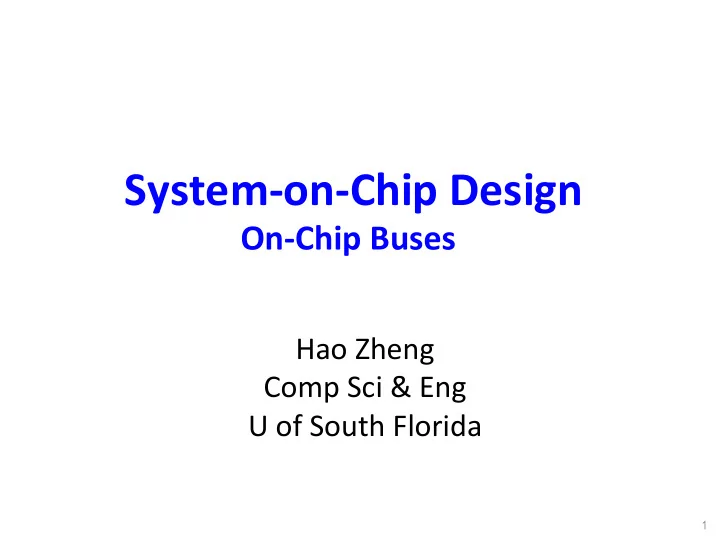

System-on-Chip Design On-Chip Buses Hao Zheng Comp Sci & Eng U of South Florida 1
Elements of a Shared Bus • Segments connected by bridges. • Bridges convert transac?ons on one segment to transac?ons on another segment • Masters ini?ate transac?ons that slaves respond. • Arbiter selects a master to control the bus fairly. • Address space assigns an unique address to each device. 2
Elements of a Shared Bus • Address wires carry memory addresses of the target slaves. • Data wires carry data to or from slaves. • Command wires carry opera?ons to be performed by slaves. • Synchroniza@on wires are used for synchroniza?on. 3
Elements of a P2P Bus Channels allow simula?on of mul?ple ports using a single port. No need for address wires. 4
Physical Connec@on of Buses Write : data flow from a master to a slave. Read : data flow from a slave to a master. Separate read & write channels allow concurrent opera?ons. 5
Bus Timing Diagrams clock edges vs clock cycles For input i , it’s high in cycle n if i is high before the clock edge n . For output o , it’s low in cycle n if o is low aJer the clock edge n . 6
Basic Write Transfers (10.2.1) m_sel: transfer validity signal wait state : hurt bus performance Time-out is needed for slow slaves. 7
Basic Read Transfers (10.2.1) 8
Improved Bus Transfers (10.2.3) • Each data transfer has mul?ple phases in sequence. – Master gets bus access by nego?a?ng with bus arbiter. – Master issues address/data/command/control. – Slave acknowledges the transfer. – Master releases the bus. • Op?miza?ons: – Transac3on spli5ng and pipelining transfers – Burst-mode opera3on 9
Transac@on SpliNng and Pipelining Transfers addr/ ctrl Write Read 10
Burst-Mode Transfers One communica3on, mul3ple data transfers, reduced overhead. 11
Mul@-Master Bus Systems (10.3) A master must talk to the arbiter first before it can communicate with a slave. 12
Mul@-Master Bus Systems: Timing Bus priority : should prevent starva?on. 13
Mul@-Master Bus Systems: Bus Locking • Locking ensures exclusive access of bus for certain dura?on of ?me. – Transfer of low priority master cannot be interrupted by the request from a high priority master. – Need of an atomic sequence of transfers. – Ensure latency requirements. 14
Mul@-Master Bus Systems: Bus Locking void leave() { int *mutex = ( int *) 0x8000; *mutex = 0; } int test_and_set() { int a; void enter() lock_bus(); while (test_and_set()); a = *mutex; } *mutex = 1; unlock_bus(); return a; } test_and_set(): lock mutex leave(): unlock mutex 15
Mul@-Master Bus Systems: Bus Locking 16
Bus Topologies (10.4) • Organiza?on of bus components and their connec?ons. • Parallel transfers on a bus must be sequen?alized. • Bus segments cannot be too long 17
Bus Topologies: Switches Masters can transfer to different slaves concurrently. • Transfers to the same slaves are sequen?alized. • 18
Bus Topologies: Crossbar Highly parallel. • expensive to implement, • Not scalable. • 19
Bus Topologies: Network-on-Chip The route between nodes are not unique. Transfer delay less predictable. Each node implements a rou?ng algorithm to find such a route and reduce conges?on. Much more scalable and parallel. 20
Reading Guide • Chapter 10, the CoDesign book. – Skip 10.2.2 21
Recommend
More recommend